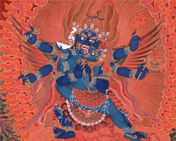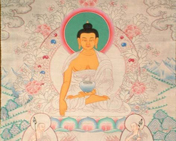Tibetan Buddhist Painting

Tibet painting originated from rock painting in ancient times. It describes visually social living, the development of religion, historical tales, local conditions and the customs of Tibet. It consists mainly of the animal images of deer, ox, sheep, horses, and hunting scenes. Painting was quite developed in ancient times, especially after Buddhism arrived, and religious painting was further developed. Buddhist Art, not only retains the best of traditional Tibetan art, but also is influenced by Indian, Nepali and Chinese Art. It's quite unique and extraordinary splendid! Tibet Buddhism is very abstruse; the artists painted distinctive images of Buddha, and many pictures of him. The painting is mainly exhibited in sculpture, wall paintings, thankas, etc.
Wall paintings contain rich content, involving religion, politics, history, economy, culture, Tibetan medicine, and social life. Any of the Buddhist scriptures, Buddhist messages, fairy tales, history stories, daily living scenes, mountains and rivers, birds and flowers, patterns and adornment can be adopted into a wall painting, which has a unique style. It uses cold and dark colors, such as black, dark blue, mauve, dark grey, brown and white; drawing with lines, especially plain lines; simple, rough and sparse outlines. It has the same style of art as the atmosphere of the monastery, and contains exaggerated and distorted art images.

Brightly colored wall paintings can be found everywhere in Tibetan monasteries. Some of them are more than 1300 years old. As it is recorded in Tibetan history, in the year when Songtsen Gampo, the Tibetan king, inherited the throne, it is said he saw Sakyamuni, Horse-necked Diamond King, Tara, Stationary Vajrapani, and the four Buddhas. He told the Nepali artisan, Ciba, to carve the four Buddhas into a rock wall and paint them. This is the earliest wall painting and sculpture. Tibetan wall painting experienced two periods. The first period starts after Songtsen Gampo became the king. Because he married a Khridzun princess of Nepal, and a Wenchen Princess of the Tang Dynasty who brought Buddhist statues and Buddhist scriptures, he built Jokhang Monastery and Romoche Monastery, which affected the development of wall painting. The figures in the wall paintings of that period are chubby, and painted with simple color, which is close to the art works at Dunhuang by Bei Wei and the beginning of the Tang Dynasty. The second period started around 10 century A.C. when the initiator of the Yellow sect, Zongkapa, reformed the religion. Yellow sects grew rapidly as the predominant religion. The number of yellow sect monasteries increased to 3000. During that period, the political and religious leaders collected many folk painters to complete wall painting jobs, and let them run in the families. That is the most splendid period of wall painting.





 8 Days Nyingchi Shigatse Namtso Tour
8 Days Nyingchi Shigatse Namtso Tour  4-Day Lhasa Join-in Group Tour
4-Day Lhasa Join-in Group Tour  5 Days Lhasa Group Tour with Yamdrok Lake
5 Days Lhasa Group Tour with Yamdrok Lake  5 Days Lhasa Pilgrimage Tour to Ganden Monastery & Drak Yerpa
5 Days Lhasa Pilgrimage Tour to Ganden Monastery & Drak Yerpa  6 Days Lhasa Shigatse Group Tour
6 Days Lhasa Shigatse Group Tour  5 Days Lhasa-Namtso-Lhasa Group Tour
5 Days Lhasa-Namtso-Lhasa Group Tour  7 Days Overland Tour from Lhasa to Kathmandu
7 Days Overland Tour from Lhasa to Kathmandu  8 Days Lhasa-Shigatse-EBC-Group Tour
8 Days Lhasa-Shigatse-EBC-Group Tour  7 Days Central Tibet Group Tour with Namtso
7 Days Central Tibet Group Tour with Namtso  Data in submission...
Data in submission...


